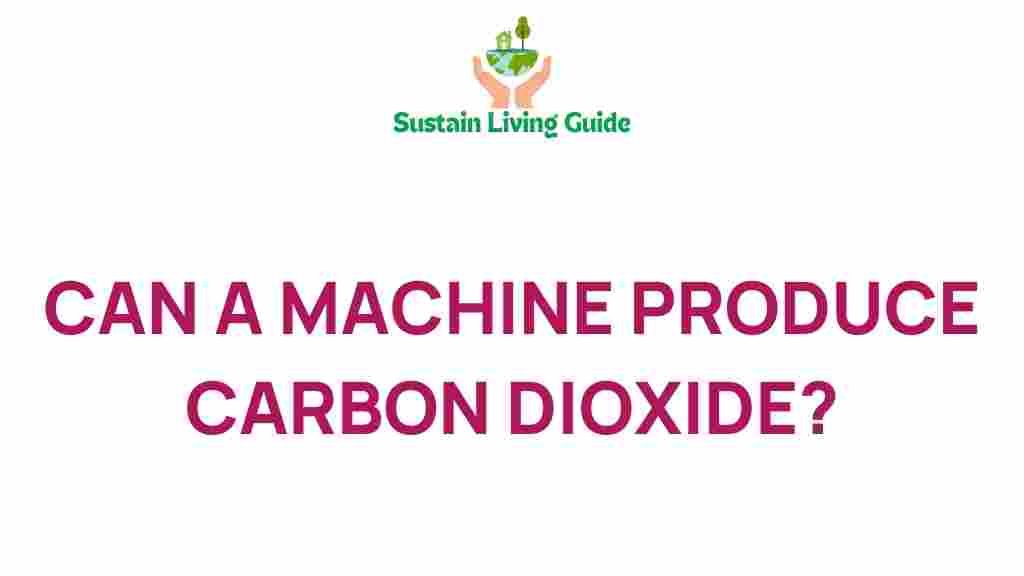Can Machines Really Produce Carbon Dioxide?
In a world increasingly focused on sustainability and environmental impact, the question of whether machines can produce carbon dioxide has become more prominent. Carbon dioxide (CO2) is a greenhouse gas that contributes to climate change, and understanding its sources is essential for reducing our overall emissions. In this article, we will delve into the mechanisms by which machines produce carbon dioxide, the types of machines involved, and the implications of their emissions on our environment.
Understanding Carbon Dioxide and Its Sources
Carbon dioxide is a colorless gas that is naturally present in the Earth’s atmosphere in trace amounts. It is produced through various natural processes, including respiration, volcanic eruptions, and the decomposition of organic matter. However, human activities, particularly the burning of fossil fuels, have significantly increased the levels of carbon dioxide in the atmosphere.
Types of Machines That Produce Carbon Dioxide
Machines that produce carbon dioxide can be classified into several categories. Here are the primary types:
- Power Generation Machines: Fossil fuel power plants, which burn coal, oil, or natural gas, are among the largest sources of CO2 emissions.
- Transportation: Vehicles such as cars, trucks, ships, and airplanes rely on combustion engines that emit carbon dioxide as a byproduct of fuel consumption.
- Industrial Machinery: Factories and manufacturing plants often burn fossil fuels for energy or use chemical processes that release CO2.
- Agricultural Equipment: Tractors and other machinery used in agriculture can also emit carbon dioxide, especially when they run on diesel or gasoline.
How Machines Produce Carbon Dioxide
The process through which machines produce carbon dioxide can be understood in a few key steps:
1. Combustion of Fossil Fuels
The primary way machines generate carbon dioxide is through the combustion of fossil fuels. When fuels such as coal, oil, or natural gas are burned, they react with oxygen in the air, leading to the formation of carbon dioxide and water vapor. This process can be summarized in the chemical equation:
CxHy + O2 → CO2 + H2O + Energy
2. Chemical Reactions in Industrial Processes
In many industrial applications, chemical reactions can produce carbon dioxide as a byproduct. For example, the cement manufacturing process releases a significant amount of CO2 when limestone (calcium carbonate) is heated to produce lime.
3. Biological Processes in Machines
Some machines, such as those used in wastewater treatment, utilize biological processes that also produce carbon dioxide. Microorganisms break down organic matter, resulting in the release of CO2.
Implications of Machine-Produced Carbon Dioxide
The emissions of carbon dioxide from machines have significant implications for the environment:
- Climate Change: Increased levels of carbon dioxide in the atmosphere enhance the greenhouse effect, leading to global warming.
- Air Quality: Emissions from machines can contribute to air pollution, which poses risks to human health.
- Regulatory Actions: Governments worldwide are implementing stricter regulations on carbon emissions, impacting how machines are designed and operated.
Reducing Carbon Dioxide Emissions from Machines
With the growing concern over carbon emissions, various strategies can be employed to reduce carbon dioxide output from machines:
1. Transition to Renewable Energy Sources
Switching from fossil fuels to renewable energy sources, such as wind, solar, or hydroelectric power, can significantly reduce carbon dioxide emissions from power generation machines.
2. Enhancing Energy Efficiency
Improving the energy efficiency of machines can lead to lower fuel consumption and, consequently, less carbon dioxide production. This can be achieved through:
- Regular maintenance of machinery.
- Upgrading to energy-efficient models.
- Implementing smart technologies to optimize performance.
3. Carbon Capture and Storage (CCS)
Carbon capture and storage technologies can capture CO2 emissions from industrial processes and power generation, preventing them from entering the atmosphere.
4. Promoting Electric Vehicles
The shift towards electric vehicles (EVs) can drastically reduce carbon dioxide emissions from the transportation sector, especially when powered by renewable energy.
Troubleshooting Common Concerns
As we strive to reduce carbon dioxide production from machines, there are common concerns that may arise:
1. High Initial Costs
While investing in renewable energy and energy-efficient machines may involve a higher upfront cost, the long-term savings and environmental benefits often outweigh these initial expenses.
2. Limited Infrastructure
In some regions, the infrastructure for electric vehicles or renewable energy sources may be lacking. Advocacy for policy changes and investment in infrastructure can help address this issue.
3. Resistance to Change
Organizations may be resistant to changing established processes. Education on the benefits of reducing carbon emissions can help foster a culture of sustainability.
Conclusion
In conclusion, machines indeed produce carbon dioxide, primarily through the combustion of fossil fuels and various industrial processes. Understanding this phenomenon is crucial as we work towards a more sustainable future. By implementing strategies to reduce carbon emissions, including transitioning to renewable energy, enhancing energy efficiency, and adopting innovative technologies, we can mitigate the impact of machines on our environment.
To learn more about sustainability practices and the future of carbon dioxide emissions, visit NRDC’s guide on climate change. For further reading on reducing carbon footprints in various sectors, check out our related articles here.
This article is in the category Greenhouse and created by SustainLivingGuide Team

3 thoughts on “Can Machines Really Produce Carbon Dioxide? Unveiling the Truth”